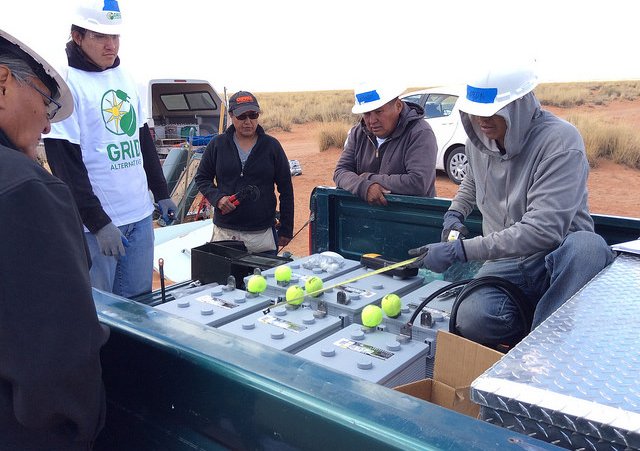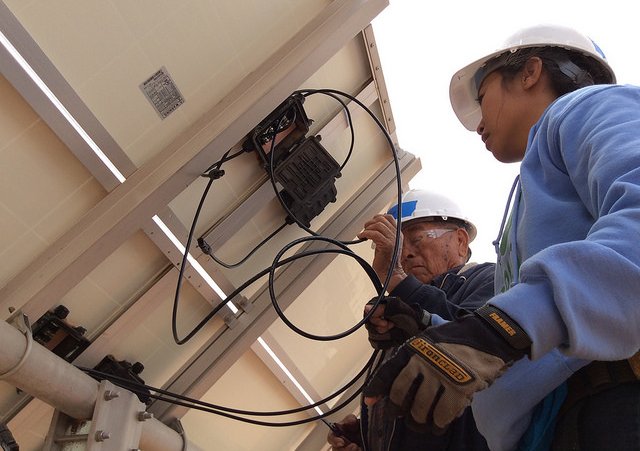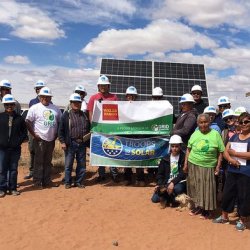Betty K Yazzie, a respected elder from the Bird Springs Navajo Chapter, lives within full-view of Dook'o'oosłííd, one of four Sacred Navajo Mountains. Wild horses drift on and off her property and a goose squawks in the background. A traditional Diné (the Navajo word for themselves), living far from electricity and water infrastructure, “Betty K” must be resilient and independent--hauling water and tending to her chickens and sheep.
Five years ago, when her late husband had health problems, her family received a battery-based solar electric system to power a refrigerator, a fan, and a few lights. Every once in a while they even watched a movie. Eventually, however, the batteries stopped functioning and she was without electricity once again.
In late March the system got new life when GRID Alternatives led a crew of local chapter members, including some veterans, in refurbishing Betty K’s system and one other nearby. The project, which included two days of classroom training and three days of hands-on work, is the start of an effort to help residents here whose systems have met similar fates, while bringing new skills to the community. It was funded by Wells Fargo as part of a national grant to support job training for veterans, with particular focus on Native American communities, where per capita military participation rates are the highest in the nation.
 Participants came out from several Navajo Chapters, including Tolani Lake, Forest Lake, Cameron, and Birdsprings, eager to learn about off-grid systems. Betty K’s system, like many others that have been installed on Navajo lands, sits all-inclusive on a metal pallet on the ground with the batteries in a bottom compartment and the charge controller and inverter above. Over time when the batteries die or something else goes wrong, there is no one there—and no funds available—to do repairs. The units also come with an attached backup propane generator for times when the batteries were too low, but these too fail due to the harsh sandy conditions of the Arizona desert. The crew replaced the batteries, rewired the systems, and upgraded them with maximum power point tracking charge controllers to increase efficiency.
Participants came out from several Navajo Chapters, including Tolani Lake, Forest Lake, Cameron, and Birdsprings, eager to learn about off-grid systems. Betty K’s system, like many others that have been installed on Navajo lands, sits all-inclusive on a metal pallet on the ground with the batteries in a bottom compartment and the charge controller and inverter above. Over time when the batteries die or something else goes wrong, there is no one there—and no funds available—to do repairs. The units also come with an attached backup propane generator for times when the batteries were too low, but these too fail due to the harsh sandy conditions of the Arizona desert. The crew replaced the batteries, rewired the systems, and upgraded them with maximum power point tracking charge controllers to increase efficiency.
Duane Benally, a Project Supervisor from the Tolani Lake Chapter, brought five chapter workers with him to the training. As with many areas of the Navajo Nation, work can be spotty, and he doesn’t always have enough project funding to keep people employed, so he tries to help them gain as many skills as possible. Plus, he says of solar, “It’s good for the Navajos to learn a modern technology in a way that honors the Navajo culture-respecting the land.
Duane’s brother Aaron, who also participated, said that the training has him interested in solar now. “It’s a lot of fun,” he said. “Everywhere can use more solar and everyone is looking for jobs out here, and the hands-on training helps get people interested.”
 Walter Tsingine, the oldest of the participants at 79 and an Army veteran, agreed. An electrician who installs similar systems in neighboring Cameron Chapter, he is looking forward to have more skilled workers to help him. “The training is excellent because I have to hire other people that know about these systems. If they learn, they can know the technology, they can do repairs and installs.” Sixty-seven systems in Cameron Chapter currently have battery problems. Walter sees solar as the future and a great help to Cameron where, as he puts it, “people are sitting with no light.”
Walter Tsingine, the oldest of the participants at 79 and an Army veteran, agreed. An electrician who installs similar systems in neighboring Cameron Chapter, he is looking forward to have more skilled workers to help him. “The training is excellent because I have to hire other people that know about these systems. If they learn, they can know the technology, they can do repairs and installs.” Sixty-seven systems in Cameron Chapter currently have battery problems. Walter sees solar as the future and a great help to Cameron where, as he puts it, “people are sitting with no light.”
During the safety huddle on Friday, Walter shared his thoughts with the group. “It’s really nice to see all of you young people out here working in a trade and developing your skills to help your community,” he said. “I regret not taking advantage of trainings when I was young.
For Betty K, whose brothers, father, grandfathers, son and now her granddaughter have served in the military, the project was a double win. It has restored power to her home, and is bringing new opportunities to her people.
Click here to see photos from the projects.

